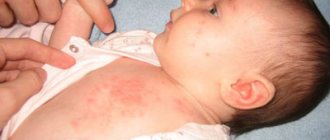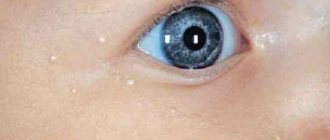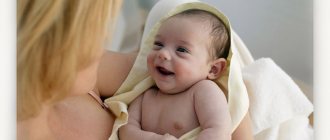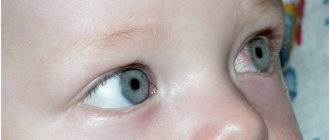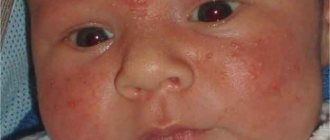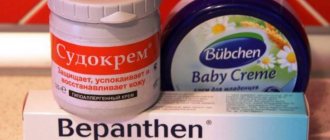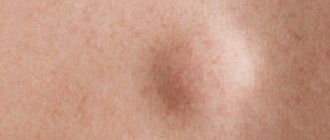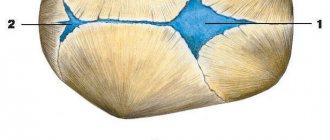The skin of newborns is very delicate; it often reacts to various negative factors with the appearance of pimples. The rash in each specific case has its own characteristics and differs in color, location and area of the affected area. The pimples themselves in newborns can be small and large, purulent and watery. There are many causes of the rash, some of them are harmless and do not require treatment, such as newborn acne, while others are a signal for immediate medical attention. Therefore, the first thing parents should do is take a good look at the rashes and the accompanying symptoms, and then try to determine why they occurred.
Acne
The cause of acne in newborns is the high level of estrogen in the mother's body during pregnancy. As a result, the hormone content in the child also increases, which leads to increased production of sebum. Pimples have a pearlescent color, sometimes with a yellowish tint. In rare cases, papules and suppurations may occur. They are most often localized on the forehead, nose and cheeks, less often on the neck and ears. In boys, rashes can occur on the genitals and groin area.
As hormone levels gradually decrease, most cases of newborn acne go away without any treatment. Sometimes doctors recommend lubricating the rash with Bepanten or an ointment containing zinc. This helps dry out pimples. But most often the only recommendation is proper skin care for the baby.
Acne in infants looks like pearlescent beads
Milia
White pimples in a newborn may also appear due to functional problems. There is such a phenomenon - milia, which is caused by underdevelopment of the sebaceous glands. The rashes look like pearls the size of a pinhead, and the places where they appear are the same as with acne in newborns: in the area under the eyes, on the nose, cheeks, and forehead.
This type of pimples also does not require treatment: as the baby grows, his hormonal levels gradually normalize. After this, the sebaceous ducts begin to function as usual, and the rash disappears.
Prickly heat
This common phenomenon consists of small red or pink rashes, sometimes bubbles with liquid appear inside, which form a crust when they dry. All this is often accompanied by itching and causes discomfort to the baby.
The reason for their occurrence is overheating. Some parents are worried that their child will freeze and catch a cold, and wrap their infants in a hundred clothes that are not suitable for the weather. The baby’s body tries to cool itself by removing sweat, but the sweat glands are still immature and cannot cope with the task, and as a result, rashes appear.
Miliaria manifests itself primarily in the neck, groin, armpits and butt. If measures are not taken to eliminate it, the rashes spread to other parts of the body. They are a favorable environment for the proliferation of various microbes, which can cause purulent inflammation of the skin. Therefore, prickly heat itself is not dangerous, but it cannot be neglected.
Miliaria rash on the back of a child
Treatment of prickly heat involves establishing optimal temperature conditions. It is necessary to ensure that the baby does not get hot, ventilate the room more often and arrange air baths. In summer, you need to bathe your baby in warm water more often. To eliminate the symptoms of the disease, you need drying ointments, bathing with the addition of a weak solution of potassium permanganate. To prevent scratching of pimples, you should promptly cut your child’s nails or use scratchers.
If the symptoms of prickly heat do not go away or purulent pimples appear, you should urgently consult a specialist.
What parents should do when pimples appear
Red spots on the face of a newborn baby
Important! If your child has acne, you need to make sure that the baby does not overheat. This is a must to keep your skin in good condition.
When a baby is too warm, skin changes worsen.
The ambient temperature must be maintained at 20-22ºC. The skin on the back of the baby's head should be warm and dry. The bath must be taken at a temperature no higher than 37ºC.
What can you do
If your baby has pimples with white heads on his face or body, you can:
- When bathing, use potassium permanganate in low concentration;
- Care for your baby’s facial skin every day by wiping it with a cotton pad moistened with boiled water;
Washing a newborn
- A decoction of the string has a good effect on the skin. It is added to the bathtub for bathing the baby or, during hygienic procedures, it is treated with cotton wool dipped in a herbal decoction on areas where redness and pimples appear.
What should you be wary of?
White pimples in a newborn usually do not require a visit to the doctor. However, you should contact your pediatrician or pediatric dermatologist if:
- The child has purulent rashes. The doctor may start treating them with antibiotic ointment. Its use is necessary due to the risk of generalization of infection;
- Despite proper hygienic care, acne does not go away and even increases;
Rash growth
- Acne lesions appear in unusual places: they are not observed on the face, but only in the armpit, in the crooks of the arms, groin, and on the neck.
Important! The doctor may recommend a zinc suspension (Tsindol), which has an anti-inflammatory and slightly drying effect, to smear on the pimples. When purulent pimples form and spread, if timely measures are not taken, the following complications may arise:
When purulent pimples form and spread, if timely measures are not taken, the following complications may arise:
- streptoderma - a bacterial infection, especially often occurring in the diaper area and skin folds;
- furunculosis.
What is prohibited to do
Milia in a newborn appear as a result of clogged skin pores. These are stagnant epidermal cysts resulting from the accumulation of sebaceous masses. Such formations are not treated, are not lubricated, and it is strictly forbidden to squeeze them, because this can lead to infection and abscess. After a few days or weeks, milia go away on their own.
Cannot be used to treat pimples:
- strong solution of potassium permanganate;
- brilliant green;
- products containing alcohol;
- Fukortsin;
- fatty and hormonal ointments.
It is also not recommended to pour baby powder directly onto your child's pimples.
Important! You cannot independently prescribe antihistamines, antibiotics, or sorbents to your baby. Emollients used to wash the baby (baby emulsions, gels and bath liquids) can be used for baby hygiene
They do not cause dry skin, do not disturb its delicate protective barrier, even strengthen it and accelerate healing
Emollients used to wash the baby (baby emulsions, gels and bath liquids) can be used for baby hygiene. They do not cause dry skin, do not disturb its delicate protective barrier, and even strengthen it and accelerate healing.
Allergic reactions
Sometimes the cause of a rash on a child's body is an allergy. It appears in the form of red spots with a small rash, sometimes flaky crusts are present. It is localized mainly on the head, behind the ears, and on the chin. What can cause allergic acne in a newborn? Here are the most common ones:
We recommend reading: How to treat heat rash in a newborn
- poor nutrition of a nursing mother, the presence of allergens in her diet (honey, sweets, red berries, etc.);
- unsuitable formula;
- the baby’s reaction to detergents that are used to wash his clothes, as well as to other care products;
- pet hair;
- dust in the baby's room.
The initial form of allergy is called diathesis. This is not a disease, but a reaction of the immune system to irritants. At this stage, it is very important to identify the factor causing the rash. It is problematic to do this on your own; it is better to seek the help of an allergist. After this, it is necessary to protect the baby from the identified irritant.
An experienced doctor will recommend how to treat allergic pimples in newborns and, if necessary, prescribe antihistamines. Among the folk methods, the most popular are bathing in herbal decoctions: string, chamomile, oregano, oak bark. It is very important to choose natural products for caring for the baby, balance the mother’s diet, do wet cleaning in the apartment more often, and choose a hypoallergenic formula when artificial feeding.
Prevention
Daily air baths will prevent the baby from many skin problems.
Parents should follow preventive measures to prevent the formation of rashes:
- A mother who is breastfeeding should carefully monitor her diet and avoid any allergenic foods.
- When feeding formula, you need to carefully choose the appropriate composition.
- The newborn should be bathed daily with special products. It is better to wash his clothes with special powders and rinses for children, then be sure to iron them.
- You need to take your child for walks often.
- When changing clothes, you need to let the newborn lie down for a while without clothes so that the skin can breathe.
- The children's room should not be hot.
Prevention of the appearance of rashes in newborns and children under one year old lies in reasonable and competent hygiene, in proper care of delicate baby skin. There are several simple rules that will help protect your baby’s skin from possible troubles and diseases:
- Bathe your newborn every day. However, you should only use baby soap once every 3-4 days. Baby up to one year old can use soap to wash their hair once a week. This will prevent the skin from drying out.
- Do not rub your baby with a towel. After water procedures, lightly blot the damp skin; a sufficient amount of liquid should remain in it.
- Be sure to wipe your child's skin with wet wipes after massage with oils. A large amount of fat makes it difficult for the skin to “breathe”.
- Give your child naked air baths every day.
- You should not use ointments and creams, as well as cosmetics that are not intended for use at an early age, even if they perfectly help adults and older children.
- Maintain optimal temperature and humidity in the room where the baby lives.
- Do not clean your home with household chemicals that contain chlorine.
- To have healthy skin, a child must eat properly. Any mother’s experiments with complementary feeding can result in the appearance of a rash.
- The child needs to be vaccinated against dangerous infections on time. The timing of vaccinations is indicated in the National Vaccination Calendar; there is no need to violate them.
- Treatment is prescribed by a doctor. Allergic, infectious and parasitic rashes cannot and should not be treated with folk remedies. This is a rule that parents should remember like a multiplication table.
- When caring for problem skin, you should adhere to the “golden” standard of dermatology - everything that is wet should be dried, and everything that is too dry should be moisturized. Therefore, for eczema and diaper rash, drying ointments and powders are used, and for dry skin, baby cream and other moisturizing creams are used. If this rule is not followed, it is unlikely that you will be able to keep your baby’s skin healthy.
- The protective properties of children's skin can be increased by strengthening the baby's general and local immunity. For general protection, walks in the fresh air, exercise, and proper nutrition are important. Local immunity will benefit from contrast douches and hardening, which can be done almost from the very birth of the child, as well as massage and air baths.
- Do not neglect protective equipment, especially if you plan to keep your baby in the sun. UV protection creams and sprays can be used on all children over six months of age.
Diaper dermatitis
Sometimes redness of the skin occurs on the baby’s thighs, buttocks and groin area, accompanied by the appearance of blisters and peeling. This is diaper dermatitis - an inflammatory reaction of delicate skin to various irritants:
- mechanical (friction caused by diapers or diapers);
- chemical (urine, digestive enzymes, salts);
- physical (overheating and humidity);
- microbial
Diaper dermatitis can easily occur in both a month-old baby and a one-year-old baby. The cause of this disease is improper child care - untimely change of diapers and nappies, as well as increased levels of ammonia in the urine and digestive enzymes in the feces. There is an increased susceptibility to diaper dermatitis, for example, impaired skin barrier functions.
The first step in treating diaper dermatitis is to keep your baby's skin dry and clean. It is advisable to use disposable diapers with an internal absorbent layer, which will help avoid skin contact with moisture. Bepanten and Desitin ointments, as well as Drapolen cream, cope well with skin redness. It is recommended to use special children's cosmetics for skin care.
Redness and peeling on the skin of the buttocks indicate diaper dermatitis
Infections
Young children often suffer from infectious diseases. Many of them can cause skin rashes:
- Rubella. First, there is an increase in temperature and enlargement of the lymph nodes in the back of the head, and on the 3-4th day a red, thin rash appears on the limbs, face and torso.
- Measles. It is characterized by a bright red rash in the form of papules that appear 3-5 days after the temperature rises. They appear in the upper part of the body and gradually move to the lower limbs.
- Roseola. First, a high temperature is observed, which lasts for three days and is not brought down by anything. After this, the child becomes thickly covered with a bright red rash.
- Chickenpox. Red spots appear all over the body, which turn into blisters with liquid. After some time they burst and form a crust. Location: the entire surface of the body.
- Scarlet fever. A bright pinpoint rash densely covers the chest, back and neck, later spreading to other parts of the body, sparing only the nasolabial area.
- Enterovirus infection is characterized by rashes on the hands and feet.
These diseases are usually harmless, but require specialist supervision. He will also tell you how to treat these diseases and how to care for your skin.
Rash on baby's skin due to chickenpox
Infectious rash
Many infections appear as red or white pimples on a newborn baby's face. It is not possible to determine the nature of their origin on your own, because this requires special tests and analyzes carried out in an inpatient or outpatient setting.
Why does a small red rash appear? There are a number of infections that cause white and red pimples on the face: scarlet fever, measles, herpes, chickenpox, rubella, Ritter's disease, enterovirus and many others. The reason is a decrease in immune defense, which in a healthy state hides external manifestations.
Is it dangerous? Yes, sure.
Any infection in an infant should be treated immediately.
This is not only an internal fight against infection with the help of tablets or injections, but also external care for rashes on the face and body of the baby. The doctor knows exactly how to carry out the therapy.
